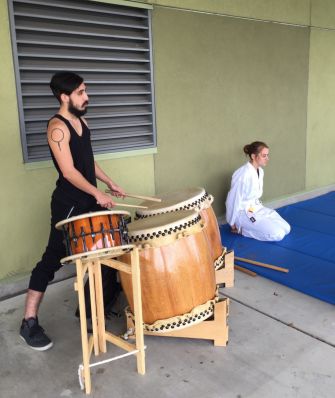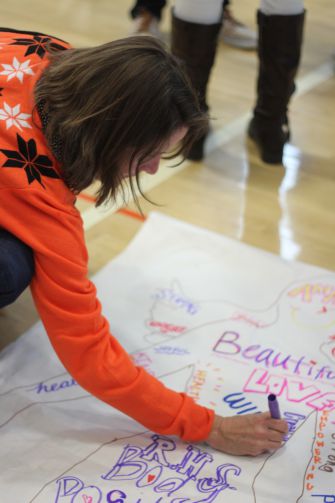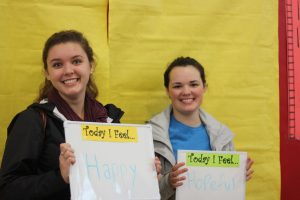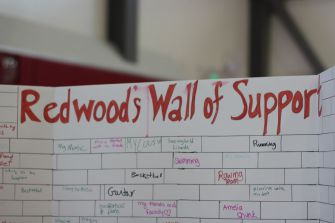The Wellness Center sponsored a Mental Wellness Week called “What’s Foggin’ Your Noggin? Let’s Get to Uncloggin!,” which began on Nov. 30.
The week was comprised of events to promote awareness of mental health and wellness and to inform students of the services that the Wellness Center provides.
Throughout the entire week, community agencies hosted mental health workshops in select classes, and there were also daily lunchtime activities.
Redwood Wellness Coordinator Jennifer Kenny-Baum spent weeks collaborating with coworkers to plan the structure of the week’s informative events.

The idea of a week dedicated to wellness awareness sparked from the results of a recent needs assessment and from the 2013-2014 California Healthy Kids Survey, according to Kenny-Baum.
Thirty-five percent of all 11th graders and 26 percent of all ninth graders at Redwood reported chronic sad or hopeless feelings in the past 12 months.
Additionally, 21 percent of 11th graders and 17 percent of ninth graders seriously considered suicide in the past 12 months.
Kenny-Baum wanted the events to teach people about mental illness, and brought in inside organizations to do so.
“Every day we had outside presenters who offered classroom presentations to teachers on different emotional health [topics],” Kenny-Baum said prior to the event. “We had people from the community, different therapists in the community, people from different agencies that specialize in emotional health, and then we also had staff on site. We had wellness staff, school counselors, we had the drama department participating. They did different presentations that teachers could sign up for to have be offered in their class.”
District Wellness Director Jessica Colvin reached out to community agencies with which Redwood has connections, and many were interested in presenting, according to Kenny-Baum.
The workshops ranged from “Teen Mental Health 101,” to “Equal Teen Relationships,” to “Detain the Strain: Coping with Stress in High School, College, and Beyond.” Some days there were 10 workshops offered, whereas other days there were only four, according to Kenny-Baum.
“We tried to pick something that would be kind of fun and interactive,” Kenny-Baum said. “[We wanted to] reach out and create alternatives, managing stress and keeping yourself well, and potentially getting people to try something new that they’ve never tried before. Or, if it’s something that you already know and love, that you get a chance to do it at school.”

The lunchtime activities consisted of aikido on Monday, yoga on Tuesday, mindfulness meditation on Wednesday, a carnivalon Thursday, and a presentation by the EPiC Drama Department on Friday.
Kenny-Baum said she chose to offer aikido as an activity because it is a stress reliever and a way to release aggression.
The aikido instructors discussed with students how to use aikido as a stress reducer.
Yoga was offered because of the effects it has on calming the mind and the body, according to Kenny-Baum.
“You’re doing something positive physically for your body in a way that you’re also allowing yourself to not be competitive in the moment,” Kenny-Baum said about the positive effects of practicing yoga. “We want to push ourselves to achieve, but each day if we aren’t well or if we’re sick, our physical limitations might alter.”
Kenny-Baum chose to have mindfulness meditation because she said it is a recommended method for combatting anxiety and depression.
However, it is also useful for those who don’t suffer from anxiety or depression because the idea of mindfulness is to learn how to pay attention in a particular moment, which is useful for everybody, regardless of mental health.
“For students who struggle with distraction, from attention deficit to sort of being a bit of a dreamer, everybody always just says pay attention, but that’s not really something you learn how to do,” Kenny-Baum said. “How do you learn how to redirect your thoughts?”
Mindful meditation is a way to quiet the mind and be present in the moment, according to Kenny-Baum.
“A lot of times multitasking is a real benefit in terms of productivity, but in terms of focus it can be a real challenge when you’re trying to juggle 50 things at one time. In order to really be present, to turn off the other things that are pulling you out of this moment, [it requires] a very specific practice,” Kenny-Baum said.
On Thursday, the carnival on the South Lawn featured about 20 different tables with information from community organizations and wellness-related games for students to play.
On Friday, the lunchtime activity was a drama department performance called FML (From My Life): Confessions from the Edge, and was based upon student-written diary entries that were transformed onstage.

“It’s all about the inner life and the emotional experience of the average high schooler, and [they performed] it onstage. I think that’s pretty great,” Kenny-Baum said.
Kenny-Baum said FML: Confessions from the Edge was performed both at lunch and during seventh period on Friday.
Body Positive, a school club that promotes positive body image, combats negative media messages and empowers people to love themselves, according to club co-president Caroline Noble.
The club tries to spread self-love through the community and will also help raise awareness for mental health throughout the Wellness Week, Noble said.
The club ran a poster campaign in the hallways and also sponsored a booth during the carnival.
At the booth, the club offered lighthearted, educational activities that raised awareness about mental health issues. Students could write their own positive comments about body perception on blank white posters.
“It’s not huge, but it’s still trying to gain awareness for the club and to get you thinking about body image. That’s the first step to changing your mindset, to really think about the messages you’re receiving,” Noble said.
Kenny-Baum invited students from freshman Social Issues classes to create games for the week.
“[Stephen Hart] has made [the students’] final in the class to create something that participates in this event,” Kenny-Baum said.
According to Kenny-Baum, Hart’s students created games for students to play at the carnival, in addition to posters to advertise the week’s events, a Redwood TV advertisement, and an app, among other creations.

“It’s really cool that they are all doing this as a part of their final—it is going to be fun,” Kenny-Baum said. “The games will be designed by students, for students.”
Kenny-Baum explained that some of the games for the carnival involved students spinning a wheel and learning information about wellness.
There was a coin toss, a “Redwood Wall” poster where students could write what made them happy,
“If you played [the games], then you got a ‘Wellness Buck’ and then you could trade those in—however many games you play—at a prize table for fun things,” Kenny-Baum said.
Winning easier games earned one “Wellness Buck,” whereas other games that took more thought earned three. Students could turn in the “Wellness Bucks” for a range of prizes.
The prizes included reusable coffee mugs, chapstick, Clif bars, and stress balls in the form of brains, all aimed at improving students’ health.






